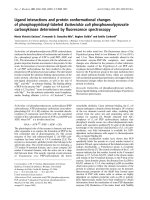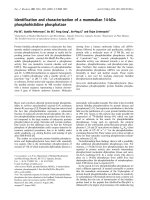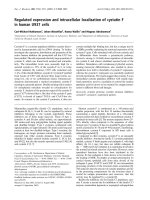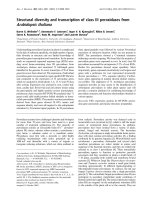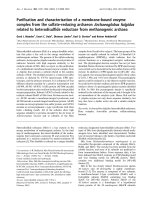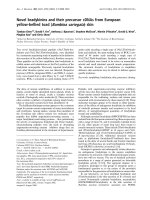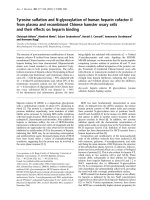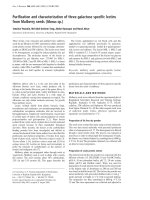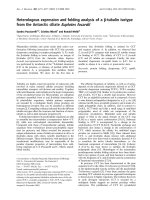Báo cáo y học: " Antismoking messages and current cigarette smoking status in Somaliland: results from the Global Youth Tobacco Survey 2004" ppsx
Bạn đang xem bản rút gọn của tài liệu. Xem và tải ngay bản đầy đủ của tài liệu tại đây (264.19 KB, 7 trang )
BioMed Central
Page 1 of 7
(page number not for citation purposes)
Conflict and Health
Open Access
Research
Antismoking messages and current cigarette smoking status in
Somaliland: results from the Global Youth Tobacco Survey 2004
Seter Siziya
1
, Emmanuel Rudatsikira
2
and Adamson S Muula*
3
Address:
1
Department of Community Medicine, University of Zambia, School of Medicine, Lusaka, Zambia,
2
Departments of Global Health,
Epidemiology and Biostatistics, School of Public Health, Loma Linda University, California, USA and
3
Department of Community Health,
University of Malawi, College of Medicine, Blantyre, Malawi
Email: Seter Siziya - ; Emmanuel Rudatsikira - ; Adamson S Muula* -
* Corresponding author
Abstract
Background: Tobacco is a leading cause of death globally. There are limited reports on current
cigarette smoking prevalence and its associated-antismoking messages among adolescents in
conflict zones of the world. We, therefore, conducted secondary analysis of data to estimate the
prevalence of current cigarette smoking, and to determine associations of antismoking messages
with smoking status.
Methods: We used data from the Somaliland Global Youth Tobacco Survey (GYTS) of 2004 to
estimate the prevalence of smoking. We also assessed whether being exposed to anti-smoking
media, education and having discussed with family members on the harmful effects of smoking were
associated with smoking. Logistic regression analysis was used to assess these associations. Current
smoking was defined as having reported smoking cigarettes, even a single puff, in the last 30 days
preceding the survey (main outcome).
Results: Altogether 1563 adolescents participated in the survey. However, 1122 had data on the
main outcome. Altogether, 15.8% of the respondents reported having smoked cigarettes (10.3%
among males, and 11.1% among females). Factors that were associated with reported non-smoking
were: discussing harmful effects of smoking cigarettes with their family members (OR = 0.61, 95%
CI 0.52, 0.71); being taught that smoking makes teeth yellow, causes wrinkles and smokers smell
badly (OR = 0.62, 95% CI 0.52, 0.74); being taught that people of the respondent's age do not
smoke (OR = 0.81, 95% CI 0.69, 0.95); and having reported that religious organizations discouraged
young people smoking (OR = 0.70, 95% CI 0.60, 0.82). However, exposure to a lot many
antismoking messages at social gatherings was associated with smoking. Exposure to antismoking
print media was not associated with smoking status.
Conclusion: A combination of school and home based antismoking interventions may be effective
in controlling adolescent smoking in Somaliland.
Published: 23 May 2008
Conflict and Health 2008, 2:6 doi:10.1186/1752-1505-2-6
Received: 18 March 2008
Accepted: 23 May 2008
This article is available from: />© 2008 Siziya et al; licensee BioMed Central Ltd.
This is an Open Access article distributed under the terms of the Creative Commons Attribution License ( />),
which permits unrestricted use, distribution, and reproduction in any medium, provided the original work is properly cited.
Conflict and Health 2008, 2:6 />Page 2 of 7
(page number not for citation purposes)
Background
Tobacco use is a leading cause of morbidity and mortality
globally. Tobacco's contribution to ill health is projected
to rise if current smoking trends are not reduced across the
world [1]. Although much of the long-term effects of
smoking are observed in adulthood, the majority of
smokers initiate the habit of smoking as adolescents.
There is a growing body of literature on adolescent
tobacco use. Much of the research on the estimate of the
prevalence and associated factors of adolescent smoking
has been driven by the Global Youth Tobacco Survey
(GYTS); an initiative spearheaded by the United States'
Centers for Diseases Control and Prevention (CDC), the
World Health Organization (WHO) and the Canadian
Public Health Association [2], and a group of authors who
have been conducting secondary analysis of GYTS data
[3]. Traditional reporting of results from the GYTS has
concentrated on ages 13 to 15 years, and estimates of
prevalence and the general socio-environment that may
be associated with teenage smoking.
Odenwald et al [4] have reported on the more than usual
use of khat in Somalia as an indication of heightened prev-
alence of substance abuse in an environment of civil strife
as is characteristic of most of Somalia. The prevalence of
any tobacco use was 32.8% (26.8% among males, and
33.1% among females) and 15.8% currently smoked cig-
arettes (10.2% among males, and 11.1% among females)
in the GYTS 2004 among adolescents 13 to 15 years of age
[5].
While the prevalence of cigarette smoking in Somaliland
has been reported, we are unaware of efforts to associate
antismoking messages with current smoking status, and
attempt to explain the prevalence of cigarette smoking
within a conceptual or theoretical framework of health
behaviors. We therefore carried out this study to estimate
the prevalence of current cigarette smoking among all
study participants in the Somaliland GYTS, identify posi-
tive antismoking messages, and explain their associations
with current smoking status within theory-based outlook.
Methods
Study setting
The Republic of Somaliland is what was previously
known as the Somaliland Protectorate under the British
rule from 1884 to 1969. The country attained independ-
ence in June 1960 around the same time that Italian
Somalia also achieved independence from Italy. On July
1st 1960 Somaliland joined the former Italian Somalia to
form the Somali Republic. A civil war was fought from
1980 onwards resulting in the eventual collapse of the
Somali Republic. Somaliland shares borders with Repub-
lic of Djibouti to the west, Federal Republic of Ethiopia to
the south and, the Red Sea to the North and Somalia to
the east.
Study design and study participant recruitment
This is a secondary analysis of data from the Somaliland
GYTS conducted in 2004. The Somaliland GYTS was a
school-based survey of students in public primary classes
6 to 8, and Secondary 1. These classes were selected
because they contained the majority of 13 to 15 years old
adolescents in Somaliland. A two-stage cluster sample
design was used to produce representative data for all of
Somaliland. At the first stage, schools were selected with
probability proportional to enrollment size. At the second
stage, classes were randomly selected and all students in
selected classes were eligible to participate. The overall
response rate was 82.9%; the school response rate was
88%, the student response rate was 94.2%. Altogether
1563 students participated in the Somaliland GYTS.
Questionnaire administration
A GYTS questionnaire was administered to students in
their classrooms during one subject session. Only stu-
dents who were present on the day a particular school was
visited participated in the study. Students who were eligi-
ble but absent were not followed up. Questionnaires were
self-completed on computer scan able survey sheets.
Students were asked among others the following ques-
tions: During the past 30 days (one month), on how
many days did you smoke cigarettes? Has anyone in your
family discussed the harmful effects of smoking with you?
During the past 30 days (one month), how many anti-
smoking media messages (e.g., television, radio, bill-
boards, posters, newspapers, magazines, movies) have
you seen or heard? When you go to sports events, fairs,
concerts, community events, or social gatherings, how
often do you see anti-smoking messages? During this
school year, were you taught in any of your classes about
the effects of smoking like it makes your teeth yellow,
causes wrinkles, or makes you smell bad?; During the past
year, did any health professionals explain to you why
smoking is dangerous to your health? During the past
year, did any religious organization discourage young
people of your age from smoking? Responses to the ques-
tions were all pre-coded. A comprehensive description of
the GYTS methodology has been reported elsewhere [6-8].
Data analysis
We obtained the data set from the CDC. Data were ana-
lyzed in SPSS 14.0 (Chicago, IL, United States of Amer-
ica). Current cigarette smoking was defined as having
smoked a cigarette, even a single puff, within the last 30
days prior to the survey. A weighted analysis was con-
ducted to obtain the prevalence of current cigarette smok-
ing as well as other relevant characteristics. Associations
Conflict and Health 2008, 2:6 />Page 3 of 7
(page number not for citation purposes)
between current smoking and categorical variables form-
ing tables with two rows and two columns were assessed
using the Yates corrected Chi-square test, and the Pearson
Chi-square test was used for higher contingency tables.
Age and sex adjusted odds ratios of current smoking and
95%CI were also obtained in a multivariate logistic regres-
sion analysis. A cut off point for statistical significance was
set at the 5% level.
In order to understand and explain the results of the quan-
titative analysis in this study, three health behavior theo-
ries i.e. the Health Belief Model (HBM), the Knowledge,
Attitude and Practice (KAP) model and the social cogni-
tive theory (SCT) were used to explained the observed
effect estimates with relation to explanatory variables [9-
13]. The SCT suggests that people's acquisition and main-
tenance of behavioral patterns is dependent on their own
cognitive capacity, as well as on social-physical environ-
ment in which they are situated. The HBM on the other
hand, promotes four constructs representing the per-
ceived threat and net benefits: perceived susceptibility,
perceived severity, perceived benefits, and perceived barri-
ers. These concepts were proposed as accounting for peo-
ple's "readiness to act." Other aspects of the model such as
"cues to action," and efficacy, were added later to the
model. Cues to action would activate readiness and stim-
ulate overt behavior. In the KAP model, it is postulated
that increased knowledge spurs people into changing
their attitudes and eventually their behaviors. How
knowledge specifically leads to behavioral change is not
well explained.
Results
Altogether 1563 adolescents participated in the survey.
For 1285 study participants who reported their sex, 63.3%
and 36.7% were males and females, respectively. How-
ever, 1122 responded to the question on whether they
smoked cigarettes in the previous 30 days. Altogether
15.8% of the respondents reported having smoked ciga-
rettes in the previous 30 days. There was no significant dif-
ference in the rate of reported smoking between sexes
(10.3% in males versus 11.1% in females).
Males tended to be older than females. Female respond-
ents were more exposed than males to antismoking media
messages; antismoking messages at sports events, fairs,
concerts, community events or social gathering; teaching
on the dangers of smoking; and antismoking messages in
newspapers or magazines. No associations were observed
between being exposed to religious organization that dis-
couraged young people from smoking and gender. Fur-
ther description of the study population is presented in
Table 1.
Table 2 shows results of multivariate analysis after adjust-
ing for age and sex. The following factors were not associ-
ated with reported smoking: being taught dangers of
smoking, frequency of antismoking posters seen, fre-
quency of antismoking messages seen in newspapers or
magazines, youth groups discouraged young people from
smoking, and health professionals explained why smok-
ing is dangerous to health. Inconsistency results were
obtained for the factor: frequency of antismoking mes-
sages seen on billboards. While there was no difference in
the odds of reported smoking between those who had not
seen messages on billboards and those who had seen a lot
of messages, respondents who had seen a few messages
were more likely to report smoking compared to those
who had not seen any message.
Factors associated with smoking
As shown in Table 2, respondents who discussed harmful
effects of smoking cigarettes with their family members
were 39% (OR = 0.61, 95%CI 0.52, 0.71) less likely to
report smoking compared to those who did not discuss
with their family members. Compared to respondents
who had not seen antismoking media messages, those
who had seen a few or too many messages were 25% (OR
= 0.75, 95%CI 0.58, 0.96) and 32% (OR = 0.68, 95%CI
0.55, 0.84) less likely to report smoking, respectively.
Respondents who had seen too many antismoking mes-
sages at social gatherings were 1.30 (95%CI 1.06, 1.60)
times more likely to report smoking compared to those
who had not seen the antismoking message at social gath-
erings. Meanwhile, respondents who were taught that
smoking makes teeth yellow, causes wrinkles and smokers
smell badly were 38% (OR = 0.62, 95%CI 0.52, 0.74) less
likely to report smoking compared to those who were not
taught. Compared to respondents who were not taught
that most people of the respondent's age do not smoke,
those who were taught were 19% (OR = 0.81, 95%CI
0.69, 0.95) less likely to report smoking. Finally, respond-
ents who reported that religious organizations discour-
aged young people from smoking were 30% (OR = 0.70,
95%CI 0.60, 0.82) less likely to report smoking compared
to those who did not report the same.
Discussion
The prevalence of current smoking was 15.8% with no sex
difference in reported smoking prevalence between males
and females. The effect of sex on susceptibility to smoking
is unclear. Some studies found that boys were at increased
risk, some studies found that it is girls who were at
increased risk, while others found no significant differ-
ence males and females [14-19].
In multivariate analysis, some knowledge or information
related factors were associated with reported non-smok-
ing while others were associated with reported smoking.
Conflict and Health 2008, 2:6 />Page 4 of 7
(page number not for citation purposes)
Table 1: Characteristics of the study population stratified by sex in the Somaliland Global Youth Tobacco Survey 2004
Total Males Females
Factor n * (%)** n * (%)** n * (%)** p value
Age
≤ 11 347 (22.9) 211 (26.6) 66 (14.1) <0.001
12 307 (20.2) 112 (13.8) 144 (31.2)
13 129 (8.6) 55 (6.9) 31 (6.6)
14 103 (6.9) 37 (4.7) 40 (8.9)
15 142 (9.8) 69 (9.2) 41 (9.5)
16 192 (13.2) 125 (16.5) 54 (12.1)
17+ 259 (18.2) 167 (22.4) 76 (17.7)
Sex
Male 813 (63.3) - - -
Female 472 (36.7) - - -
Frequency of antismoking media messages seen or heard
A lot 835 (59.6) 468 (61.1) 288 (64.9) <0.001
A few 338 (25.1) 186 (25.8) 94 (21.7)
None 210 (15.2) 100 (13.2) 59 (13.4)
Family member discussed harmful effects of smoking
Yes 1045 (76.4) 615 (81.7) 309 (70.6) <0.001
No 327 (23.6) 140 (18.3) 130 (29.4)
Frequency of antismoking messages seen at sports events, fairs, concerts, community events or
social gathering
A lot 490 (34.5) 266 (34.1) 163 (37.5) <0.001
Some 281 (19.8) 158 (20.5) 68 (15.6)
None 655 (35.8) 354 (45.3) 205 (46.8)
Taught dangers of smoking
Yes 713 (50.9) 404 (52.4) 249 (55.3) 0.008
No 660 (49.1) 351 (47.6) 193 (44.7)
Taught that smoking makes teeth yellow, causes wrinkles and smokers smell badly
Yes 738 (52.0) 478 (60.6) 179 (39.5) <0.001
No 657 (48.0) 298 (39.4) 264 (60.6)
Frequency of antismoking posters seen
A lot 566 (40.5) 314 (41.7) 160 (36.4) <0.001
Some 339 (24.2) 173 (23.0) 111 (25.3)
None 490 (35.3) 266 (35.4) 166 (38.3)
Frequency of antismoking messages seen on billboards
A lot 641 (45.2) 389 (50.3) 167 (37.1) <0.001
Some 352 (24.7) 166 (21.5) 133 (29.2)
None 419 (30.1) 216 (28.2) 148 (33.7)
Frequency of antismoking messages seen in newspapers or magazines
A lot 516 (36.9) 270 (35.7) 179 (39.9) <0.001
Some 500 (36.7) 282 (37.9) 147 (34.3)
None 372 (26.4) 204 (26.4) 117 (25.9)
Taught that most people of respondent's age do not smoke cigarettes
Yes 630 (46.3) 367 (49.5) 178 (41.7) <0.001
No 753 (53.7) 391 (50.5) 255 (58.3)
Health professional explained why smoking is dangerous to health
Yes 602 (46.7) 352 (49.9) 177 (41.5) <0.001
No 674 (53.3) 348 (50.1) 241 (58.5)
Religious organization discouraged young people from smoking
Yes 990 (73.9) 540 (74.7) 322 (74.9) 0.878
No 358 (26.1) 189 (25.3) 110 (25.1)
Youth groups discouraged young people from smoking
Yes 748 (58.9) 453 (62.2) 211 (53.6) <0.001
No 513 (41.1) 272 (37.8) 177 (46.4)
Current smoker
Yes 183 (15.8) 65 (10.3) 37 (11.1) 0.248
No 939 (84.2) 554 (89.7) 283 (88.9)
Numbers not adding up because of missing information.
* unweighted frequencies.
** weighted percentages.
Conflict and Health 2008, 2:6 />Page 5 of 7
(page number not for citation purposes)
Factors associated with knowledge of the harmful effects
of smoking (having discussed with family or taught in
school about harms of smoking) were associated with
reported non-smoking. According to the HBM, teaching
adolescents on the dangers of smoking may be important
to enhance their perception of the severity of the condi-
tion. Individuals who perceived smoking as harmful to
health would be less likely to smoke. In addition, the KAP
model's aim would be to improve the knowledge levels of
the adolescents thereby leading to behavioral change. Pre-
vious reports on school based smoking intervention pro-
grams have shown mixed results [20-22]. We again
believe that the content and mode of delivery of these pro-
grams do matter as to their effectiveness.
It is interesting to note that exposure to anti-smoking mes-
sages through health workers, and print media (posters,
billboards, newspapers, and magazines) was not associ-
ated with current reported smoking status. However, hav-
ing been exposed to anti-smoking messages through
sports or community events seem to have achieved a neg-
ative result of exposure to these messages being associated
with reported smoking. This finding highlights the fact
that the content and the delivery mode of anti-smoking
Table 2: Results of antismoking messages and smoking status in multivariate analysis, adjusted for age and sex in the Somaliland GYTS
2004
Factor Adjusted Odds ratio (95% confidence interval)
Frequency of antismoking media messages seen or heard
A lot 0.68 (0.55, 0.84)
A few 0.75 (0.58, 0.96)
None 1
Family member discussed harmful effects of smoking
Yes 0.61 (0.52, 0.71)
No
Frequency of antismoking messages seen at sports events, fairs, concerts, community events or
social gathering
A lot 1.30 (1.06, 1.50)
Some 0.90 (0.72, 1.13)
None 1
Taught dangers of smoking
Yes 0.90 (0.72, 1.13)
No 1
Taught that smoking makes teeth yellow, causes wrinkles and smokers smell badly
Yes 0.62 (0.52, 0.74)
No 1
Frequency of antismoking posters seen
A lot 0.93 (0.73, 1.18)
Some 1.06 (0.83, 1.36)
No 1
Frequency of antismoking messages seen on billboards
A lot 0.87 (0.66, 1.14)
Some 2.34 (1.86, 2.94)
No 1
Frequency of antismoking messages seen in newspapers or magazines
A lot 1.17 (0.92, 1.48)
Some 0.82 (0.67, 1.00)
No 1
Taught that most people of respondent's age do not smoke cigarettes
Yes 0.81 (0.69, 0.95)
No 1
Health professional explained why smoking is dangerous to health
Yes 0.97 (0.83, 1.14)
No 1
Religious organization discouraged young people from smoking
Yes 0.70 (0.60, 0.82)
No 1
Youth groups discouraged young people from smoking
Yes 0.89 (0.76, 1.04)
No 1
Conflict and Health 2008, 2:6 />Page 6 of 7
(page number not for citation purposes)
messages may result in possibly unintended conse-
quences.
Cohen et al [23] in their review of 399 televised anti-
smoking advertisements that were designed to discourage
adult and teen smoking found that most advertisements
had emphasized the consequences of smoking more than
the viewer's self-efficacy to quit smoking. Within the HBM
and KAP models, these advertisements may have
improved knowledge of harmful effects of smoking (per-
ceived severity) but were limited in promoting self-effi-
cacy that may spur the smoker to quit. Furthermore,
advertisements were more likely to use informational and
humor appeals, rather than sadness, fear, or anger
appeals. Biener et al [24] have reported that anti-smoking
advertisements featuring messages about serious health
consequences that had been independently rated as high
in negative emotion were more likely to be recalled and
were perceived as more effective by youth survey respond-
ents than ads featuring messages about normative behav-
ior for teens or ads relying on humor. Advertising
intensity, while contributing to recall, was negatively
related to perceived effectiveness.
Flay and Sobel [25], and Rogers and Storey [26] have
reported that mass media anti-smoking messages that
promote inter-personal communication are more effec-
tive than those that do not. We found that adolescents
who were exposed to interpersonal communication were
less likely to report smoking than if they had not. We also
believe that many of the billboards, posters, and newspa-
per anti-smoking messages may have possibly been a
health warning on a pro-tobacco advert. Such advertise-
ments, promoting glamour are less likely to result in
reduced smoking among adolescents. Thrasher et al [27]
have reported that cigarette packages whose warning
labels contain prominent graphic imagery are more likely
than text-only warning labels to promote smoking-related
knowledge and smoking cessation.
Mass media campaigns are performed to promote health
knowledge, change attitudes and may change behavior
[28-32]. The KAP model, if effective, would be expected to
lead to reduced smoking rates among adolescents. Staten
and Ridner [33] have reported that inappropriate messag-
ing may be less effective if no targeting is used.
We found that adolescents who reported that their reli-
gion discouraged smoking were less likely to report smok-
ing. The lower rates of reported smoking could have been
mediated through social norms within society where if
society perceives a practice as unbecoming, adolescents
are less likely to smoke. However, results on the positive
role of religion are not consistent. Knowledge of pro-
nouncement that smoking was sin was not associated
with lower level of smoking in Egypt [34].
Adolescents who were taught that people of their age do
not smoke may have reported less smoking as a result of
improved efficacy that they are able not to smoke, as well
as in conformity to normative beliefs (social cognitive the-
ory).
Limitations of the study
This study has a number of limitations. Firstly, data were
collected through self-reports. To the extent that study
participants misreported, either intentionally or inadvert-
ently, our results may be biased. The study also only
recruited students. Adolescents who were out of school
were, therefore, not represented. Furthermore reported
current cigarette smoking was not verified by appropriate
biomarkers such as cotinine level or exhaled carbon mon-
oxide [35-37].
Conclusion
In a study of school-going adolescents in Somaliland, we
found that adolescents who were exposed to anti-tobacco
messages or discussions in school and at home were less
likely to report smoking than those who were not exposed
to such experiences. A combination of school and home
based antismoking interventions may be effective in the
control of adolescent smoking in Somaliland. Exposure to
anti-smoking print messages was not associated with
reported non-smoking in the current study, and we pro-
pose that studies be done on the effectiveness of anti-
smoking messages (in terms of size, color and content) on
adolescent smoking in Somaliland.
Competing interests
The authors declare that they have no competing interests.
Authors' contributions
SS led data analysis, participated in the interpretation of
findings and drafting of manuscript. ASM participated in
the interpretation of the findings and drafting of the man-
uscript. ER participated in the interpretation of the find-
ings and drafting of the manuscript. All authors read and
approved the final manuscript
Acknowledgements
We thank the Centers for Disease Control and Prevention, National
Center for Chronic Disease Prevention and Health Promotion, Office on
Smoking and Health for making available the data used in this study.
References
1. Ezzati M, Lopez AD, Rodgers A, Hoorn S Vander, Murray CJ: Com-
parative Risk Assessment Collaborating Group: Selected
major risk factors and global and regional burden of disease.
Lancet 2002, 360:1347-60.
2. Warren CW, Jones NR, Peruga A, Chauvin J, Baptiste JP, Costa de
Silva V, el Awa F, Tsouros A, Rahman K, Fishburn B, Bettcher DW,
Asma S: Centers for Disease Control and Prevention (CDC):
Publish with Bio Med Central and every
scientist can read your work free of charge
"BioMed Central will be the most significant development for
disseminating the results of biomedical researc h in our lifetime."
Sir Paul Nurse, Cancer Research UK
Your research papers will be:
available free of charge to the entire biomedical community
peer reviewed and published immediately upon acceptance
cited in PubMed and archived on PubMed Central
yours — you keep the copyright
Submit your manuscript here:
/>BioMedcentral
Conflict and Health 2008, 2:6 />Page 7 of 7
(page number not for citation purposes)
Global youth tobacco surveillance, 2000–2007. MMWR Surveill
Summ 2008, 57:1-28.
3. Siziya S, Muula AS, Rudatsikira E: Correlates of current cigarette
smoking among school-going adolescents in Punjab, India:
results from the Global Youth Tobacco Survey 2003. BMC Int
Health Hum Rights 2008, 8:1.
4. Odenwald M, Hinkel H, Schauer E, Neuner F, Schauer M, Elbert TR,
Rockstroh B: The consumption of khat and other drugs in
Somali combatants: a cross-sectional study. PLoS Med 2007,
4:e341.
5. Global Youth Tobacco Survey (GYTS): Somalia – Somaliland.
[ />somalia_factsheet.htm].
6. Kyrlesi A, Soteriades ES, Warren CW, Kremastinou J, Papastergiou P,
Jones NR, Hadjichristodoulou C: Tobacco use among students
aged 13–15 years in Greece: the GYTS project. BMC Public
Health 2007, 7:3.
7. Stojiljkovic D, Haralanova M, Nikogosian H, Petrea I, Chauvin J, War-
ren CW, Jones NR, Asma S: Prevalence of tobacco use among
students aged 13–15 years in the South-eastern Europe
health network. Am J Health Behav 2008, 32:438-45.
8. Warren CW, Riley L, Asma S, Eriksen MP, Green L, Blanton C, Loo
C, Batchelor S, Yach D: Tobacco use by youth: a surveillance
report from the Global Youth Tobacco Survey project. Bull
World Health Organ 2000, 78:868-76.
9. Glanz K, Rimer BK, Lewis FM: Health Behavior and Health Edu-
cation. In Theory, Research and Practice San Fransisco: Wiley & Sons;
2002.
10. Bandura A: Self-efficacy: The exercise of control. New York:
Freeman; 1997.
11. Champion VL: Instrument development for health belief
model constructs. ANS Adv Nurs Sci 1984, 6:73-85.
12. Becker MH, Radius SM, Rosenstock IM: Compliance with a medi-
cal regimen for asthma: a test of the health belief model. Pub-
lic Health Reports 1978, 93:268-77.
13. Eisen M, Zellman GL, McAlister AL: Health Belief Model-Social
Learning Theory approach to adolescents' fertility control:
findings from a controlled field trial. Health Educ Q 1992,
19:A249-62.
14. Feighery E, Borzekowski DL, Schooler C, Flora J: Seeing, wanting,
owning: the relationship between receptivity to tobacco
marketing and smoking susceptibility in young people. Tob
Control 1998, 7:123-8.
15. Gritz ER, Prokhorov AV, Hudmon KS, Mullin Jones M, Rosenblum C,
Chang CC, Chamberlain RM, Taylor WC, Johnston D, de Moor C:
Predictors of susceptibility to smoking and ever smoking: a
longitudinal study in a triethnic sample of adolescents. Nico-
tine Tob Res 2003, 5:493-506.
16. Kaufman NJ, Castrucci BC, Mowery PD, Gerlach KK, Emont S, Orle-
ans CT: Predictors of change on the smoking uptake contin-
uum among adolescents. Arch Pediatr Adolesc Med 2002,
156:581-7.
17. Straub DM, Hills NK, Thompson PJ, Moscicki AB: Effects of pro-
and anti-tobacco advertising on nonsmoking adolescents'
intentions to smoke. J Adolesc Health 2003, 32:36-43.
18. Ertas N: Factors associated with stages of cigarette smoking
among Turkish youth. Eur J Public Health 2007, 17:155-61.
19. Global Youth Tobacco Survey Collaborating Group: Differences in
worldwide tobacco use by gender: findings from the Global
Youth Tobacco Survey. J Sch Health 2003, 73:207-15.
20. Huang TT, Unger JB, Rohrbach LA: Exposure to, and perceived
usefulness of, school-based tobacco prevention programs:
associations with susceptibility to smoking among adoles-
cents. J Adolesc Health 2000, 27:248-54.
21. Wiehe SE, Garrison MM, Christakis DA, Ebel BE, Rivara FP: A sys-
tematic review of school-based smoking prevention trials
with long-term follow-up. J Adolesc Health 2005, 36:162-9.
22. Hwang MS, Yeagley KL, Petosa R: A meta-analysis of adolescent
psychosocial smoking prevention programs published
between 1978 and 1997 in the United States. Health Educ Behav
2004, 31:702-19.
23. Cohen EL, Shumate MD, Gold A: Original: anti-smoking media
campaign messages: theory and practice. Health Commun
2007, 22:91-102.
24. Biener L, Ji M, Gilpin EA, Albers AB: The impact of emotional
tone, message, and broadcast parameters in youth anti-
smoking advertisements. J Health Commun 2004, 9:259-74.
25. Flay BR, Sobel JL: The role of mass media in preventing adoles-
cent substance abuse. In Preventing adolescent drug abuse: interven-
tion strategies Edited by: Glynn TJ, Leukefled CG, Ludford JP. Rockville,
MD: National Institute on Drug Abuse, US Department of Health and
Human Services; 1983:5-35.
26. Rogers M, Storey JD: Communication campaigns. In Sage New-
bury Park Edited by: Berger CR, Chaffee SH. CA: Handbook of Com-
munication Science; 1987:817-46.
27. Thrasher JF, Hammond D, Fong GT, Arillo-Santillán E: Smokers'
reactions to cigarette package warnings with graphic
imagery and with only text: a comparison between Mexico
and Canada. Salud Publica Mex 2007, 49(Suppl 2):S233-40.
28. Maibach E, Flora J, Nass C: Changes in self-efficacy and health
behavior in response to a minimal contact community
health campaign. Health Commun 1991, 3:1-15.
29. Cummings KM, Sciandra R, Markello : Impact of a newspaper
mediated quit smoking program. Am J Public Health 1987,
77:1452-3.
30. Farquhar JW, Maccoby N, Wood PD, Alexander JK, Breitrose H,
Brown BW Jr, Haskell WL, McAlister AL, Meyer AJ, Nash JD, Stern
MP: Community education for cardiovascular health. Lancet
1977, 1:1192-5.
31. Farquhar JW, Fortmann SP, Flora Ja, Taylor CB, Haskell WL, Williams
PT, Maccoby N, Wood PD: Effects of communitywide education
on cardiovascular disease risk factors: the Stanford Five-City
Project. JAMA 1990, 264:359-65.
32. Ershoff DH, Quinn VP, Mullen PD, Lairson DR: Pregnancy and
medical cost outcomes of a self-help prenatal smoking cessa-
tion program in a HMO. Public Health Rep 1990, 105:340-7.
33. Staten RR, Ridner SL: College students' perspective on smoking
cessation: "If the message doesn't speak to me, I don't hear
it". Issues Ment Health Nurs 2007, 28:101-15.
34. Radwan GN, Israel E, El-Setouhy M, Abdel-Aziz F, Mikhail N,
Mohamed MK: Impact of religious rulings (Fatwa) on smoking.
J Egypt Soc Parasitol 2003, 33(Suppl 3):1087-101.
35. Hung J, Lin CH, Wang JD, Chann CC: Exhaled carbon monoxide
level as an indicator of cigarette consumption in a workplace
cessation program in Taiwan. J Formos Med Assoc 2006,
105:210-3.
36. Jenkins RA, Counts RW: Personal exposure to environmental
tobacco smoke: salivary cotinine, airborne nicotine, and non-
smoker misclassification. J Expo Anal Environ Epidemiol 1999,
9:352-63.
37. Low EC, Ong MC, Tan M: Breath carbon monoxide as an indi-
cation of smoking habit in the military setting. Singapore Med
J 2004, 45:578-82.
